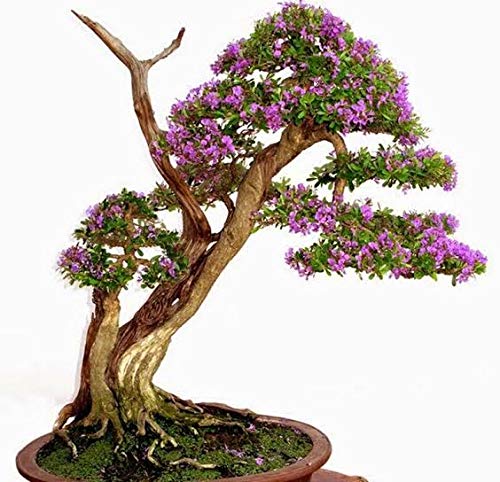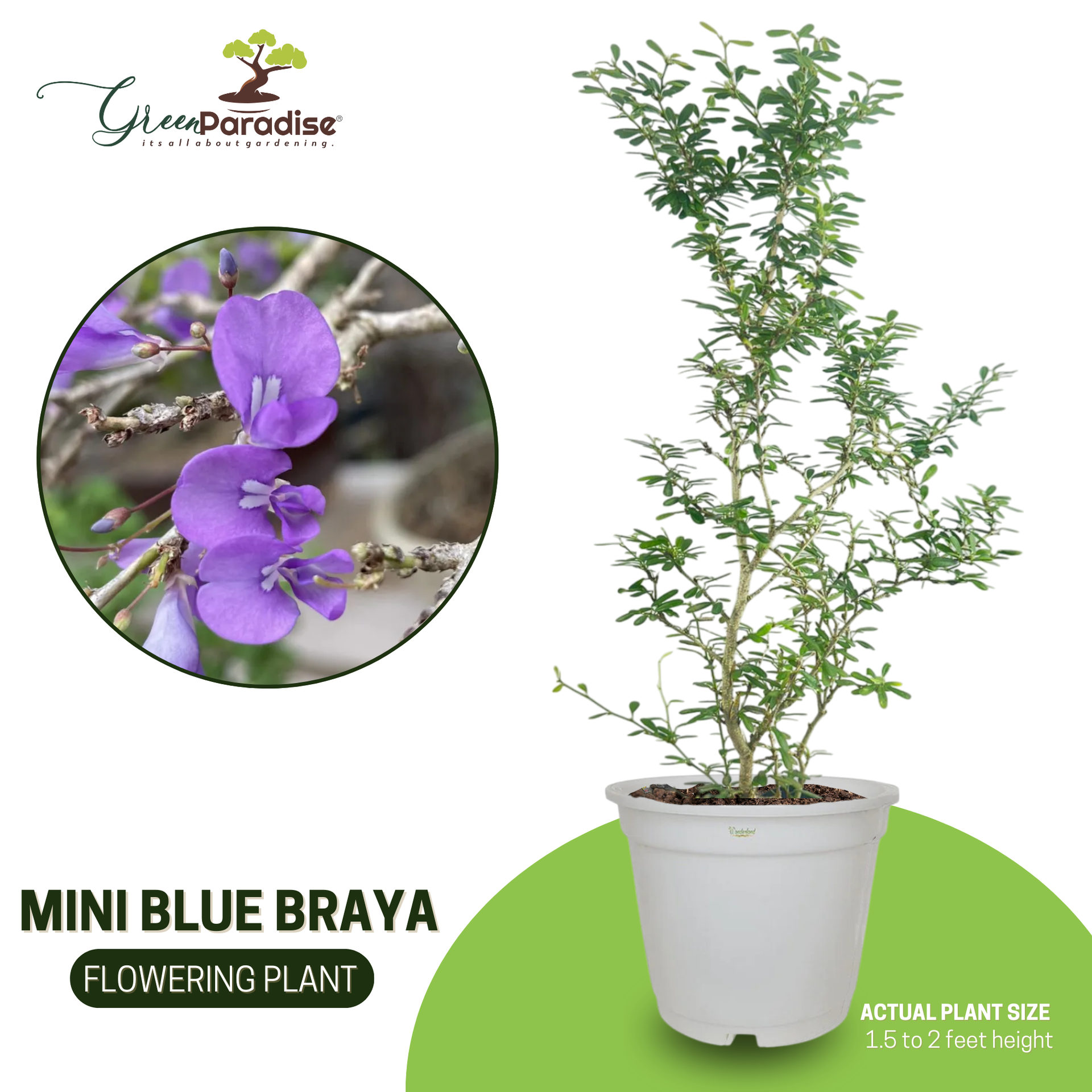



Green Paradise Offers Beautiful Blue Braya Plant
About Blue Braya Plant
These plants are distributed in various regions, including tropical and subtropical areas worldwide.
Critical characteristics of Blue Braya plants include their trifoliate leaves, which resemble the typical clover leaves with three leaflets. The flowers are typically small and arranged in clusters or racemes. The flowers are often purple or pink, although they can also be white or yellow in some species. After pollination, Blue Braya plants produce small, flattened, and segmented pods containing seeds.
Blue Braya species are known for their nitrogen-fixing abilities. Like other legumes, they form symbiotic relationships with nitrogen-fixing bacteria called rhizobia. These bacteria reside in nodules on the roots of Blue Braya plants and convert atmospheric nitrogen into a form that the plants can utilize as a nutrient. This process enriches the soil with nitrogen, making Blue Braya valuable in agroforestry and soil improvement.
Due to their nitrogen-fixing properties and ability to establish in diverse habitats, some Blue Braya species are used as cover crops and green manure in agricultural systems. They can help improve soil fertility, prevent soil erosion, and suppress weed growth.
Apart from their agricultural importance, certain Blue Braya species have also been utilized in traditional medicine for various purposes. Some of the reported medicinal uses include treating respiratory issues, fevers, gastrointestinal disorders, and skin conditions.
One well-known species of Blue Braya is Blue Braya gangeticum, also known as Sal-leaved Desmodium. This plant has a long history of medicinal use in Ayurvedic medicine, particularly for respiratory and digestive ailments.
It is important to note that while some Blue Braya species have positive attributes like nitrogen fixation and medicinal uses, others may be considered invasive and unwanted in certain regions.
Always exercise caution and seek proper guidance before using any plant for medicinal purposes, as some may have side effects or interactions with medications. If you are considering growing Blue Braya for agricultural purposes, consult local agricultural experts to ensure you select the appropriate species for your specific needs and environmental conditions.
How To Grow Blue Braya Plant
These plants are known for their ability to fix nitrogen in the soil, making them valuable for enriching the soil and improving its fertility.
Taking care of a Blue Braya plant involves providing the right growing conditions and regular maintenance.
To grow the value Blue Braya plant, follow these general guidelines:
Choose the Right Variety:
There are many species of Blue Braya, and some may be more suitable for your specific climate and growing conditions than others. Research and choose a species that is well-adapted to your region.
Planting Time:
Blue Braya is typically grown from seeds. Plant the seeds during the appropriate planting season for your region. Follow the instructions on the seed packet for the best timing.
Soil Preparation:
Blue Braya prefers well-draining soil with good fertility. Prepare the soil by removing any weeds and adding organic matter like compost to improve soil structure and nutrients. Use well-draining, loose potting soil that retains some moisture but does not become waterlogged. A blend of peat moss, perlite, and regular replanting soil is suitable.
Planting Seeds:
Sow the seeds directly into the soil at the recommended depth, usually about 1/4 inch deep. Space the seeds according to the plant's mature size, usually around 12-18 inches apart.
Watering:
Keep the soil constantly wettish but not doused during the germination period. Once the plants are established, they are generally drought-tolerant, but they will still benefit from regular watering during dry periods. Keep the soil constantly wettish but not doused. Allow at least an inch (2.5 cm) of soil to dry between waterings. Use room-temperature water and avoid using chlorinated water if possible. Overwatering can lead to root spoilage, so it's important not to let the factory sit in standing water.
Sunlight:
Blue Braya plants thrive in full sunlight. Make sure they admit at least 6- 8 hours of direct sun daily. Blue Braya plants prefer bright, indirect sunlight. Place your plant near a window with filtered light or in a location where it receives partial sunlight. Avoid direct Sun, as it can scorch the delicate leaves.
Fertilization:
As nitrogen-fixing plants, Desmodium does not require much additional fertilization. However, if the soil is poor, you can apply a balanced fertilizer during the growing season to support the plant's overall health. During the growing season (spring and summer), feed your Blue Braya plant with a balanced liquid fertilizer every two to four weeks. In the dormant season (fall and winter), reduce or stop fertilizing.
Mulching:
Applying mulch around the plants can help retain soil moisture, control weeds, and provide additional organic matter as it breaks down.
Pruning:
Some Blue Braya species can be vigorous growers and may benefit from occasional pruning to maintain shape and encourage bushier growth. Trim back leggy or dead growth to encourage bushier growth and to maintain the plant's shape.
Pest and Disease Control:
Keep an eye out for common garden pests and diseases. Treat any infestations or issues instantly to help them from spreading.
Support:
Some species of Blue Braya may benefit from support, especially if they have a trailing or climbing habit. Young Blue Braya plants may need repotting annually, while older ones can be repotted every two to three years. Repot in the spring when the plant is actively growing and has outgrown its current container.
Overwintering:
Depending on your climate and the specific Blue Braya species you're growing, you may need to take appropriate measures to protect the plant during colder months.
Remember that the specific care requirements may vary based on the species of Blue Braya you are growing, so it's essential to research and learns about the particular needs of the plant you have chosen. Observing and adapting to the local conditions and the specific plant's preferences will lead to a successful and thriving Blue Braya plant.
Temperature:
These plants thrive in average to warm temperatures, ideally ranging from 65°F to 80°F (18°C to 27°C). They are sensitive to cold drafts, so avoid placing them in areas with temperature fluctuations.
Humidity:
Blue Braya plants prefer moderate to high humidity levels. You can increase humidity around the plant by misting its leaves regularly or placing a tray of water near the plant.
Posts:
Keep an eye out for common houseplant pests like spider mites, aphids, and mealybugs. If you notice any infestation, treat the plant with appropriate insecticidal soap or neem oil.
Propagation:
Blue Braya plants can be propagated through stem cuttings. Take 4-6 inches (10-15 cm) cuttings from the tip of healthy stems and root them in water or a well-draining potting mix.
Remember that different species of Blue Braya might have specific care requirements, so it's essential to identify the exact species you have to provide the best care possible. Observe your plant regularly to ensure it stays healthy and make adjustments to its care as needed.




